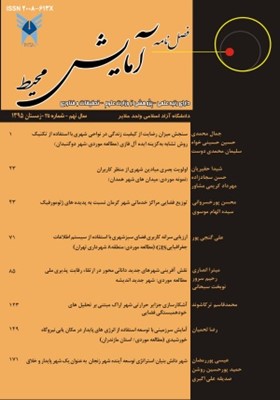آشکارسازی جزایر حرارتی شهر اراک مبتنی بر تحلیلهای خودهمبستگی فضایی
محورهای موضوعی : آمایش محیط
1 - استاد گروه جغرافیا دانشگاه پیام نور
کلید واژه: خودهمبستگی فضایی, جزایر حرارتی شهری (UHI), دمای سطح زمین (LST), تحلیل لکههای داغ, شهر اراک,
چکیده مقاله :
ارزیابی جزایر حرارتی شهری یک متغیر کلیدی در مطالعات علوم محیطی محسوب میشود، چراکه با مدل کردن تعاملات شار سطح زمین میتوان به بسیاری از مشکلات شهرنشینی جامعه مدرن پاسخی بهینه داد. این مطالعه باهدف آشکارسازی جزایر حرارتی شهر اراک و خوشهای شدن آن به رشته تحریر در آمده است. بدین منظور ابتدا تصاویر حسگرهای و ماهواره لندست 8 برای ماه اوت سه سال متوالی 2013، 2014 و 2015 از پایگاه علوم زمین ایالاتمتحده امریکا ( ) اخذ گردید. برای استخراج مقادیر UHI از LST از تابعهای خودهمبستگی موران جهانی و تحلیل لکههای داغ با استفاده از قابلیتهای برنامهنویسی محیطهای و استفاده شد. بعد از محاسبه دمای سطح زمین (LST) با استفاده از شاخص تحلیل لکههای داغ ( ) خوشههای گرم و سرد جزایر حرارتی اراک استخراج شدند. برای ارزیابی عوامل مؤثر در شکلگیری و خوشهای شدن جزایر حرارتی شهر اراک از دو شاخص NDVI و NDBI بهره برده شد. نتایج نشان داد که دو پارامتر پوشش گیاهی و مناطق ساختهشده شهری با دمای سطح زمین همبستگی قوی دارند، بطوریکه شاخص پوشش گیاهی باعث تعدیل جزایر حرارتی شهری و مناطق ساختهشده شهری موجب تشدید جزایر حرارتی شهری اراک گردیدهاند. ارزیابی تطبیقی جزایر حرارتی اراک منجر به آشکارسازی دو نوع جزیره حرارتی شهری گردید؛ جزایر حرارتی کانونی و جزایر حرارتی خطی. تحلیل خودهمبستگی فضایی با شاخصهای موران جهانی نشان داد که دمای سطح زمین اراک دارای ساختار فضایی بوده یا به عبارتی دمای سطح زمین اراک به شکل خوشهای توزیعشدهاند. درنهایت تحلیل لکههای داغ ( ) تأییدی آشکار بر متمرکز شدن و خوشه ای شدن جزایر حرارتی شهر اراک در فضا با افزایش دوره زمانی بوده است.
The assessment of urban heat islands is considered as a key variable in the studies of environmental sciences because modeling the interactions of the land surface flux can best respond to many urban problems of modern societies. This study aimed to detect heat islands over Arak city and their clustering was done. For this purpose, the satellite images of Landsat 8 (OLI and TIRS) related to August for three consecutive years 2013, 2014 and 2015 were taken from the United States Geological Survey (USGS) Site. For the extraction of Urban Heat Islands (UHI) values of Land Surface Temperatures (LST), Moran's autocorrelation functions and hot spot analyses by MATLAB and Arc GIS capabilities were used. After land surface temperature (LST) calculation, hot and cold clusters of heat islands over Arak were extracted using the hot spot analysis index. To evaluate the factors affecting on the formation and clustering of heat islands in Arak NDVI and NDBI indices were used. The results showed that there is a high correlation between the two parameters, vegetation and urban built areas with land surface temperature so that the vegetation index has moderated and urban built areas has exacerbated the heat islands over Arak city. Comparative assessment of urban heat islands led to the detection of two types of heat islands over Arak: Focal heat islands and the linear heat islands. Moran's spatial autocorrelation analysis revealed that the land surface temperature has spatial structure in Arak; in other words, land surface temperature is distributed in clusters in Arak. Finally, analysis of hot spots is a clear confirmation on focus and clustering of heat islands over Arak by increasing the time period.
_||_

